Wildlife in Antarctica- A Visitor’s Guide to Antarctic Wildlife
Purchases made through links earn us a small commission, at no extra cost to you.
The abundance of animals in Antarctica make the continent a bucket list destination for wildlife lovers, bird watchers, and those looking to see some of Earth’s most well known creatures.
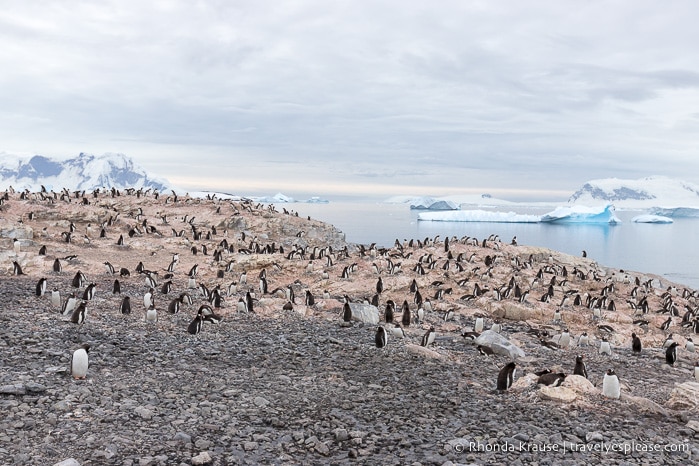
Antarctica is a wonderfully wild place where you can see huge concentrations of marine mammals and seabirds living side by side, thriving in one of the harshest climates on Earth.
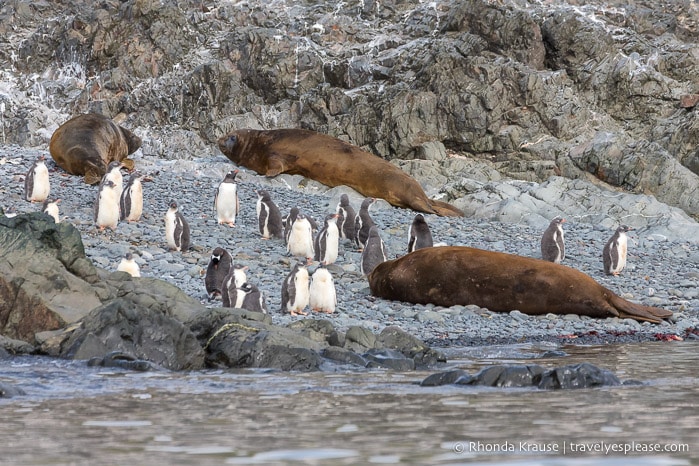
Undoubtedly, seeing the density of Antarctic wildlife, learning about each species’ characteristics, and watching their behaviour from close proximity were the highlight of our trip to Antarctica.
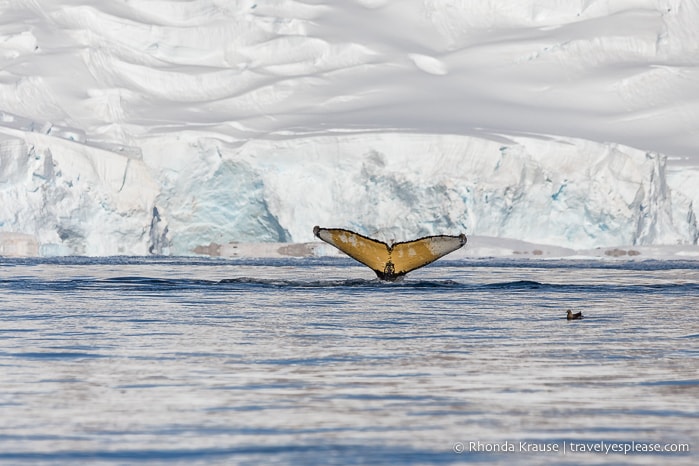
Wildlife in Antarctica- A Visitor’s Guide to Antarctic Wildlife
If you’re preparing for your first trip to Antarctica, it’s not unreasonable to assume you’ll see plenty of penguins, but you can also look forward to seeing several other types of Antarctic wildlife.
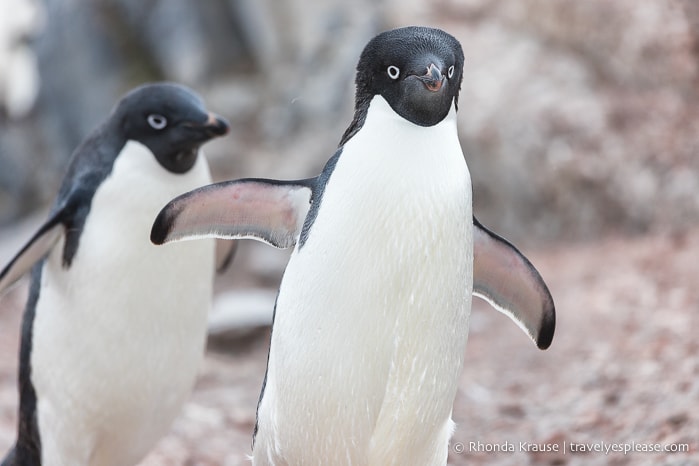
Here’s a list of the main categories of animals you can see in Antarctica along with some interesting facts, tips for identifying them, and certain behaviours we witnessed.
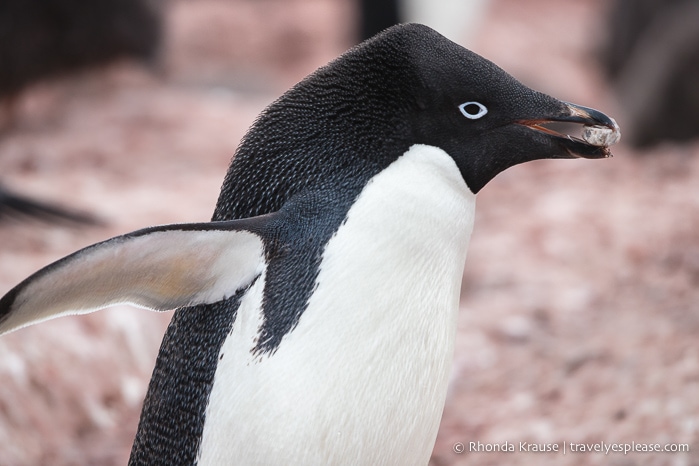
Keep in mind that specific sightings can’t be guaranteed, even though expedition leaders try their very best to ensure guests see a range of species and as many animals in Antarctica as possible.
So, without further ado, we present the wildlife of Antarctica!
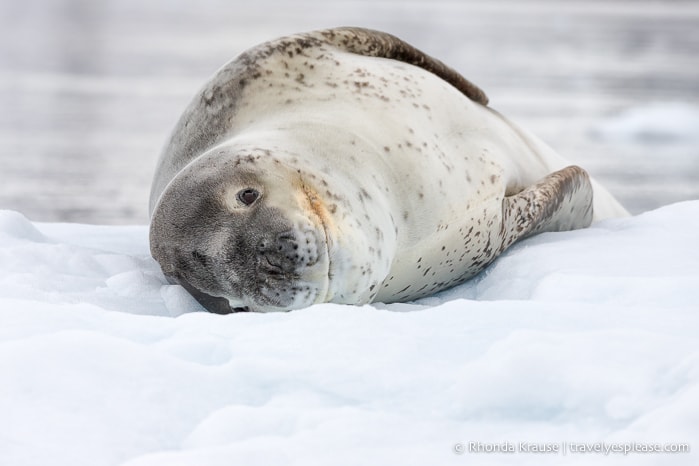
Penguins in Antarctica
Of all the wildlife in Antarctica, penguins are the most well known and frequently seen on trips to the White Continent. It’s estimated that there are approximately 20 million breeding pairs of penguins in the Antarctic, concentrated in coastal regions.
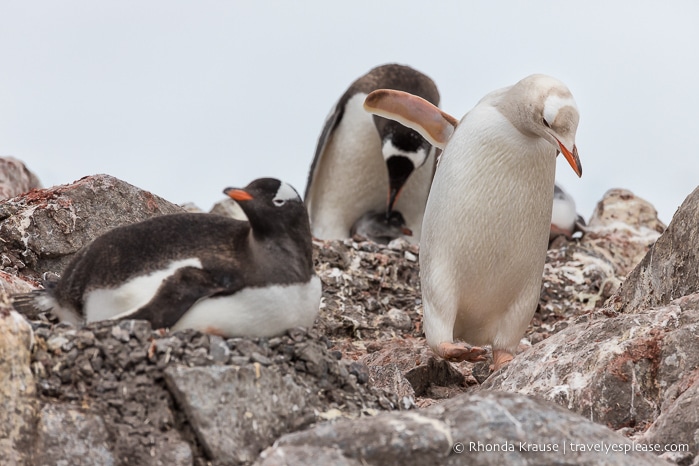
Visiting penguin colonies, known as rookeries, is the main activity on Antarctic cruises. It’s always entertaining to watch these flightless birds waddle, dive, swim, and hop up to surprisingly great heights. They are very social too and make a lot of noise communicating with each other.
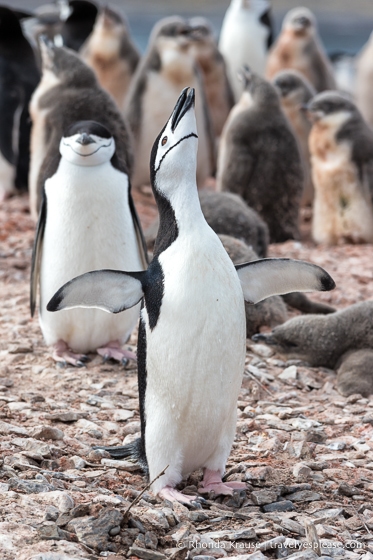
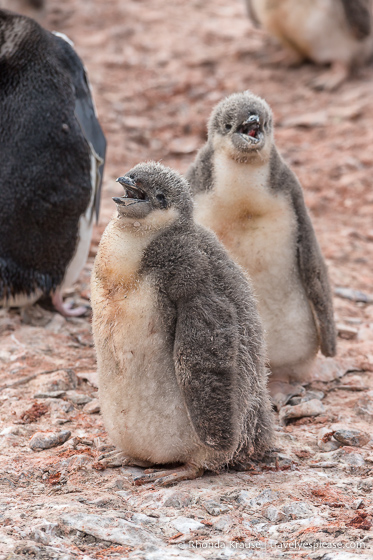
The Antarctic region is home to six species of penguins- Adelie, chinstrap, emperor, gentoo, king, and macaroni.
Gentoo, chinstrap, and Adelie are the penguins most commonly seen on trips to Antarctica, since cruises mainly visit the peninsula where they breed.
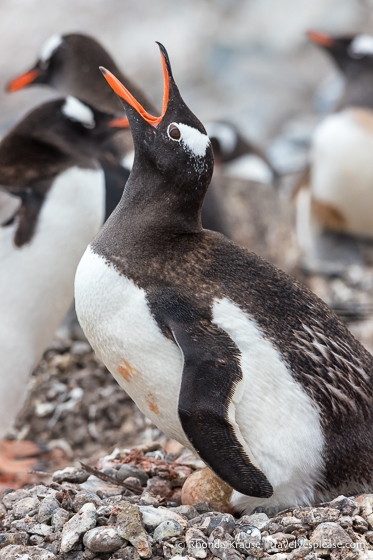
King penguins only breed on warmer, subantarctic islands (South Georgia is home to many huge colonies), so you won’t see them on the Antarctica continent. Macaroni penguins are more commonly seen in subantarctic regions as well, but there is one rookery on the Antarctic peninsula.
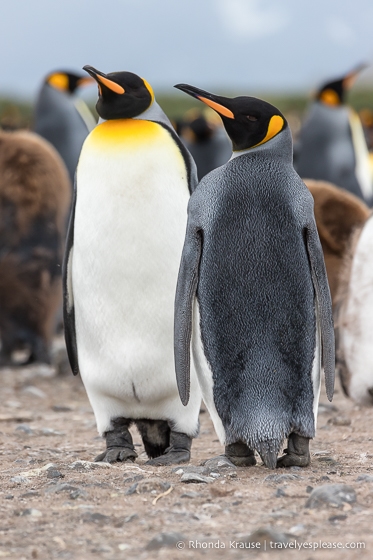
Emperor penguins breed the farthest south, live on sea ice surrounding the continent, and are the least common Antarctic penguin (about 200,000 breeding pairs). The majority of cruises to Antarctica won’t visit an emperor colony since they’re difficult to reach, so to see them you’ll have to book a special expedition to the Weddell sea.
Gentoo Penguins
Gentoo penguins can be found on the Antarctic peninsula and surrounding islands. Unlike the emperor penguin, gentoos prefer ice-free areas so you’ll see them nesting on beaches and low hilltops.
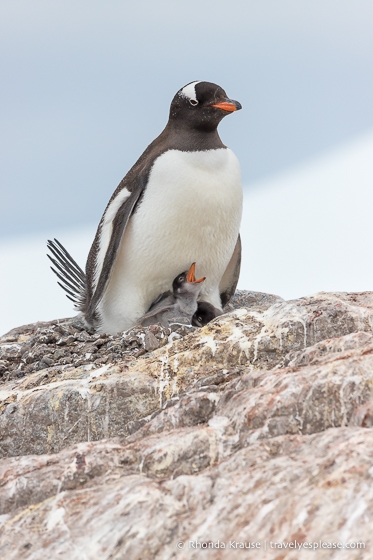
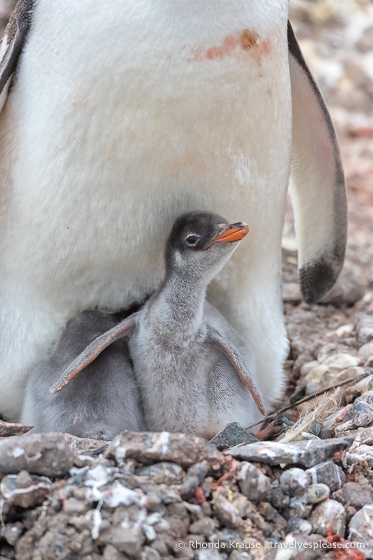
Standing about 75 cm (2.5 ft) tall and weighing just over 12 lbs, gentoos are the third largest penguin. They can be identified by their bright orange beak, peach-coloured feet, and brush-like tail that sweeps when they walk. Their streamlined bodies and strong flippers help them swim faster than any other diving bird.
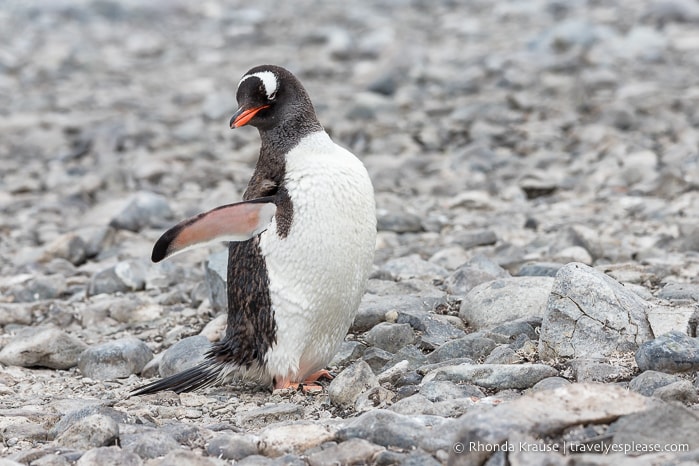
When we saw gentoo penguins they were usually in small groups and more modest sized colonies. The largest gentoo colony in Antarctica, at Cuverville Island, has about 6,500 pairs, which is much smaller than other penguin colonies.
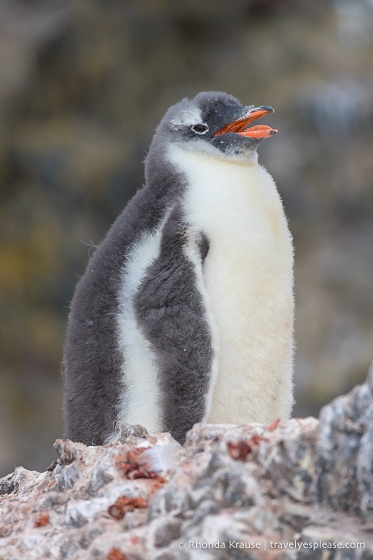
Since gentoos are less likely to stick together than other penguins, we’d often see them mingling with other species, even getting close to elephant seals.
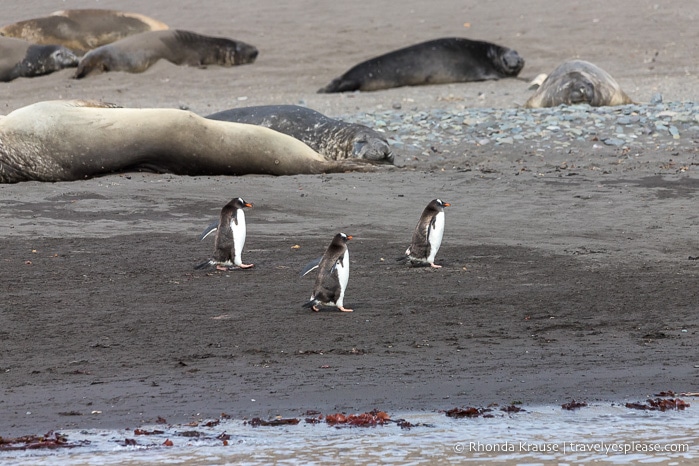
At first it was surprising to see them so close to seals, but we later learned that adult penguins have no land-based predators. Good thing, because penguins are really clumsy and awkward on land so wouldn’t be able to defend themselves well!
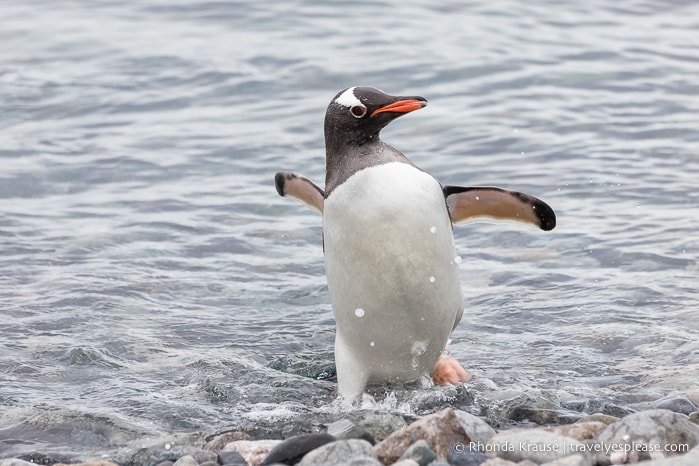
Chinstrap Penguins
Chinstrap penguins live mostly on the Antarctic Peninsula, nesting on ice-free slopes in large colonies. With an estimated 8 million breeding pairs on the peninsula, the chinstrap is the most abundant penguin in Antarctica.
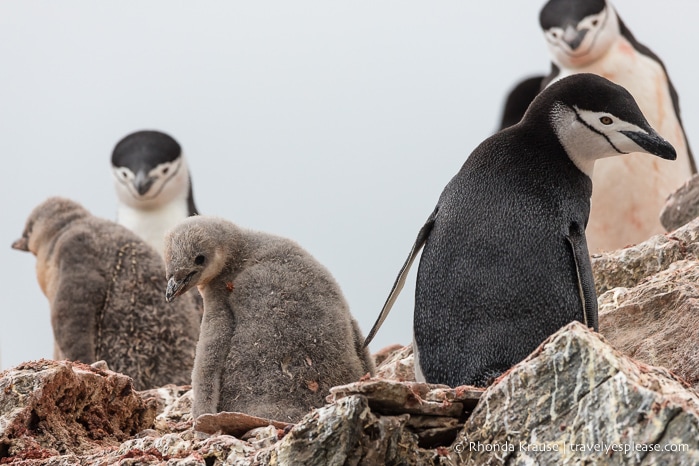
Chinstrap penguins grow to be about 71 cm (2.3 ft) tall and 11 lbs. They are one of the easiest penguins to identify because of the black line of feathers under their chin, which is where the name chinstrap comes from.
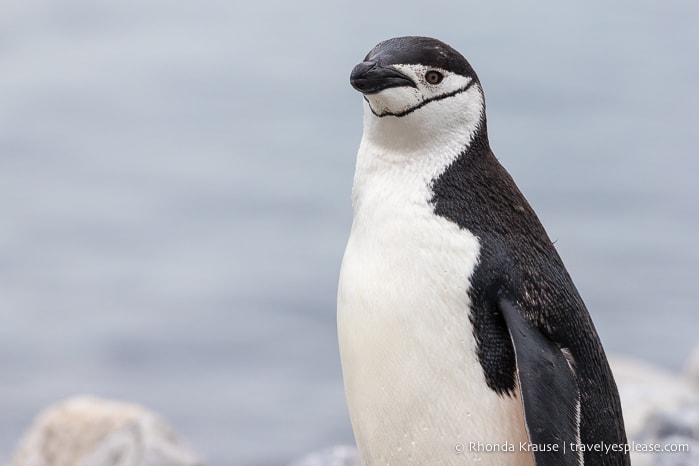
Even though chinstraps live in some of the largest penguin colonies (some over 100,000 pairs), we often saw them alongside gentoo and Adelies, their closest relatives, as well as macaroni penguins.
What was most impressive about chinstrap penguins was how high they would climb on rocky coastal slopes, up to 122 m (400 ft) in places. These areas make good nest sites because they become free of ice early in the spring.
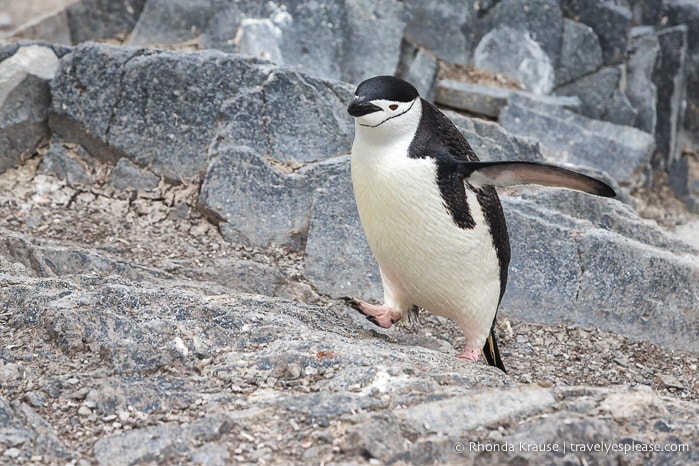
Adelie Penguins
Adelie penguins are found in many different locations on and around the Antarctic continent. They spend summer on the coast and winter offshore around the pack ice.
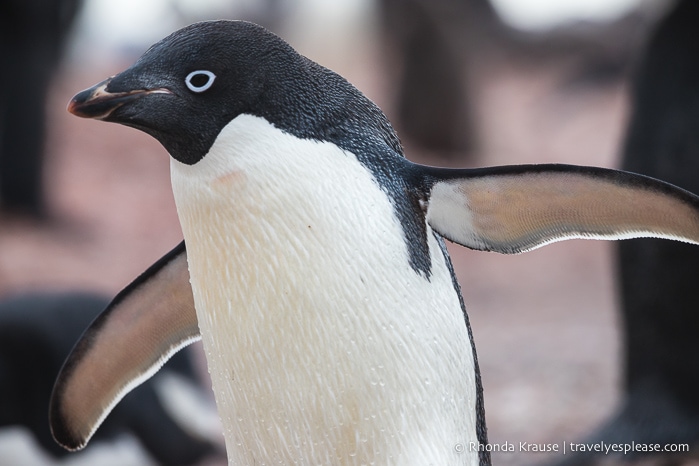
Adelie penguins are also 71 cm (2.3 ft) tall but slightly heavier than a chinstrap, at 11.7 lbs. Many consider them to be the cutest penguin in Antarctica because their white chest and black head and back makes it look like they’re wearing a tuxedo. Their white-rimmed eyes also add some extra expression to their feisty personalities.
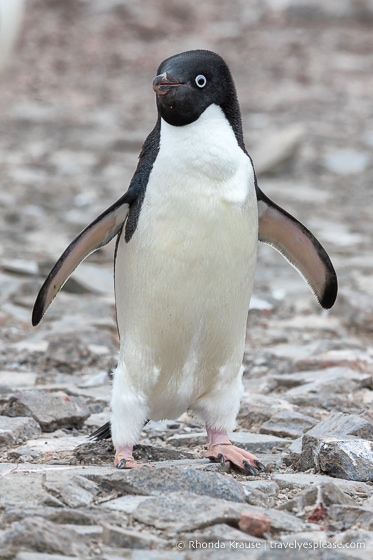
At one of the Adelie colonies we visited it was fun to watch how active and social they are. They were constantly interacting with and “talking” to each other, stealing rocks from each other’s nests, and making their chicks chase them around for food.
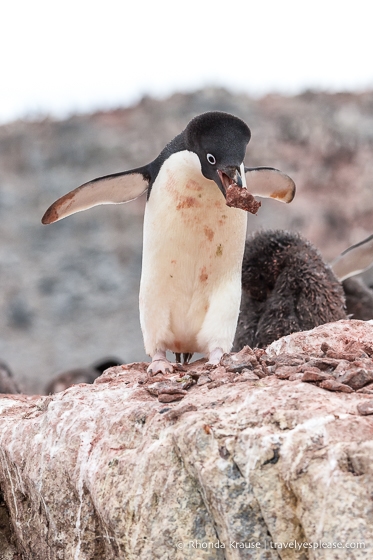
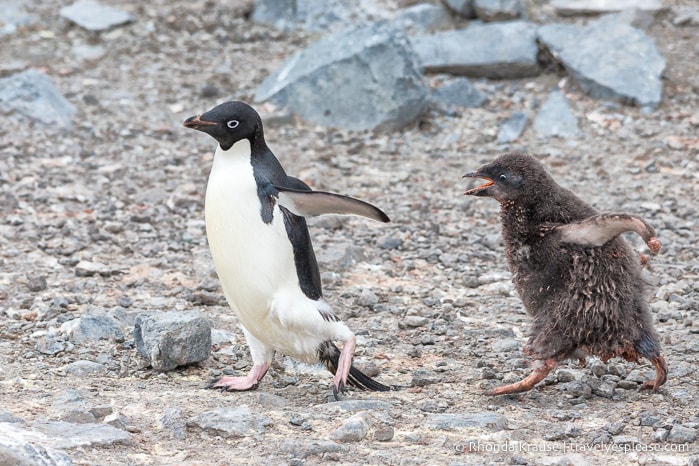
Another interesting and amusing behaviour we noticed was how they gather together at the edge of the water, all eager to jump in but not wanting to be the first to take the plunge. Once one finally dived or hopped in, the rest quickly followed!
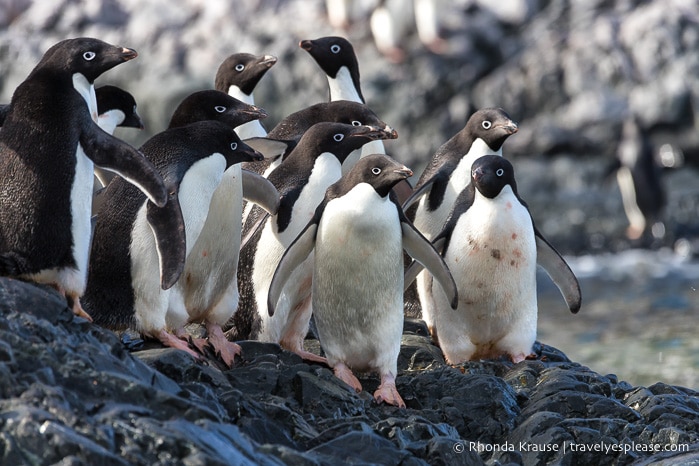
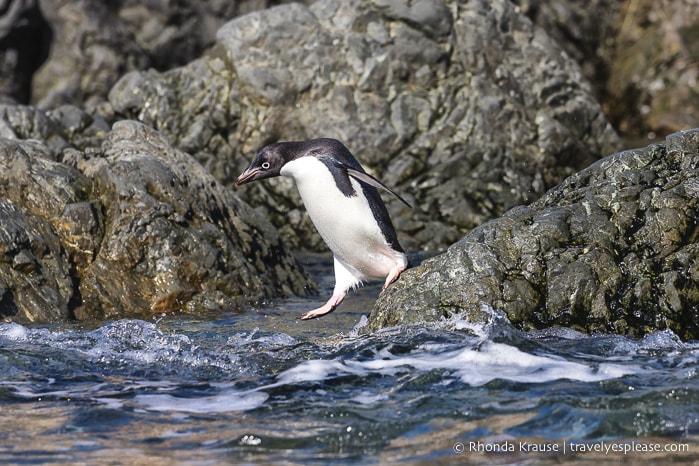
Macaroni Penguins
Macaroni penguins are the most numerous penguin in the world, at around 12 million breeding pairs, but only some live in Antarctica (they primarily inhabit subantarctic islands).
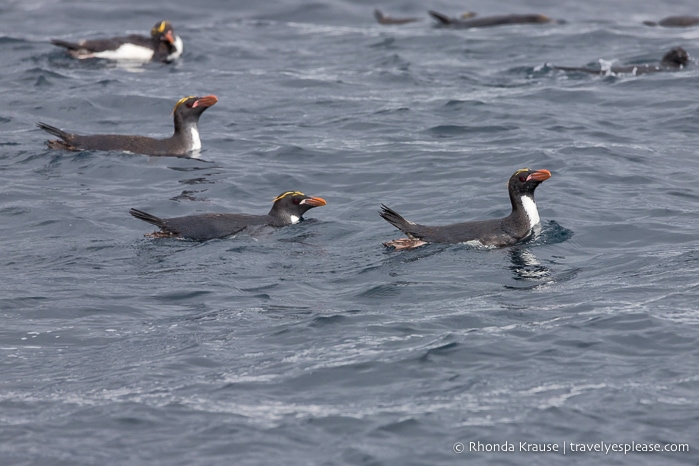
Macaroni penguins are the same size as chinstraps, measuring in at 71 cm (2.3 ft) and 11 lbs. Like other crested penguins, macaronis have a golden yellow plume on their head (kind of like eyebrows). This conspicuous yellow crest led to sailors naming them “macaronis”, after a type of flamboyant 18th-century fashion. Other identifying features of macaroni penguins are red eyes and a thick orange bill with a pink patch of skin in the corner.
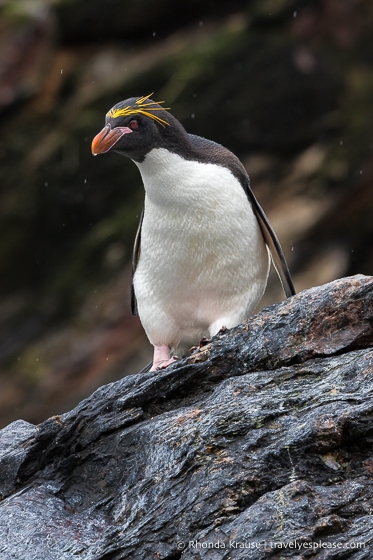
Since macaroni penguins look a little devious, we weren’t surprised to see some males acting aggressively towards each other by “shouting” through wide open beaks and slapping their flippers.
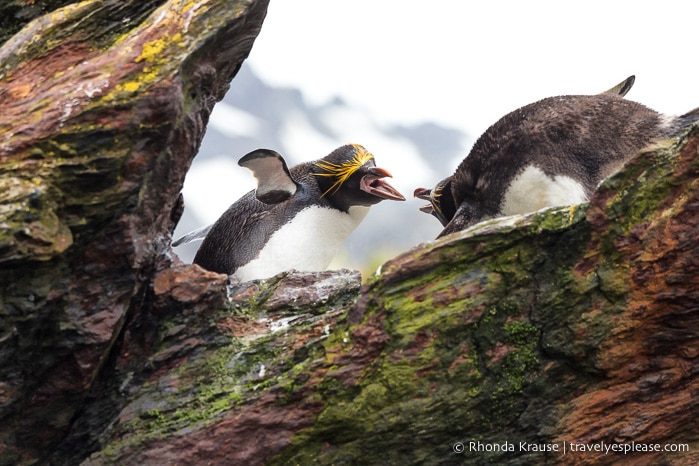
Seals in Antarctica
After penguins, the most frequently spotted wildlife in Antarctica are seals.
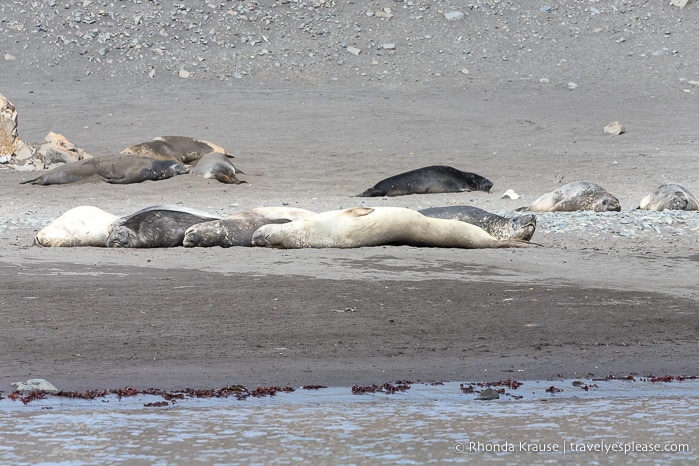
There are two groups of seals- eared seals and true seals- and both can be seen in Antarctica. The difference between the two groups is whether they have an external ear (eared seals) or a small aperture on the side of their head (true seals).
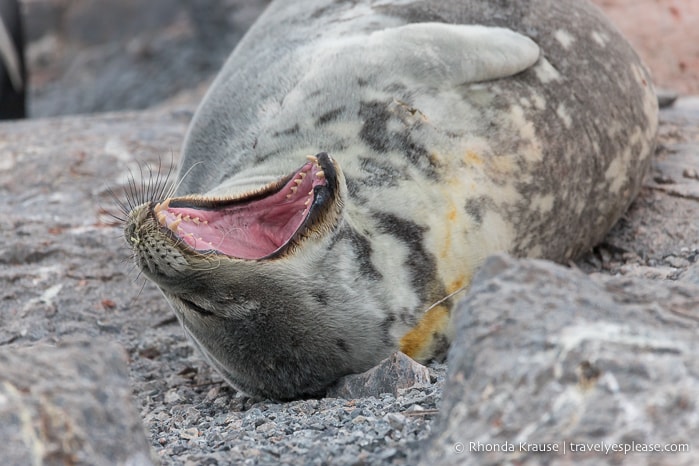
Within those two groups, there are six species of seals that live in Antarctica- leopard, crabeater, Ross, Weddell, Antarctic fur, and southern elephant.
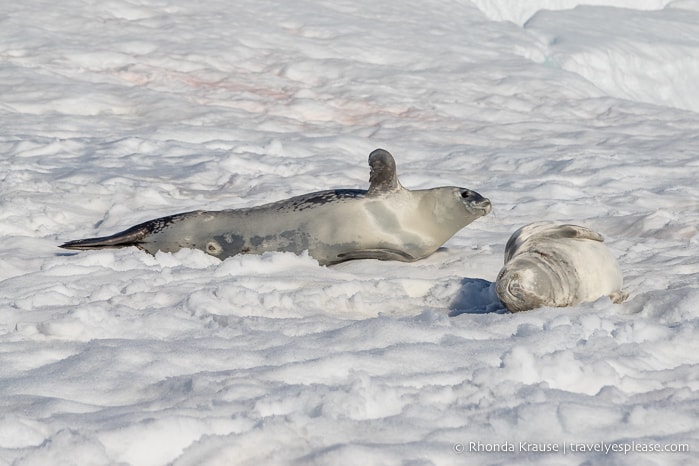
Seals are usually spotted while visiting penguin colonies and on scenic zodiac cruises. We’d see them swimming in coastal waters, lounging on the shorelines, and floating on pieces of ice. They only leave the water to breed, molt, and rest.
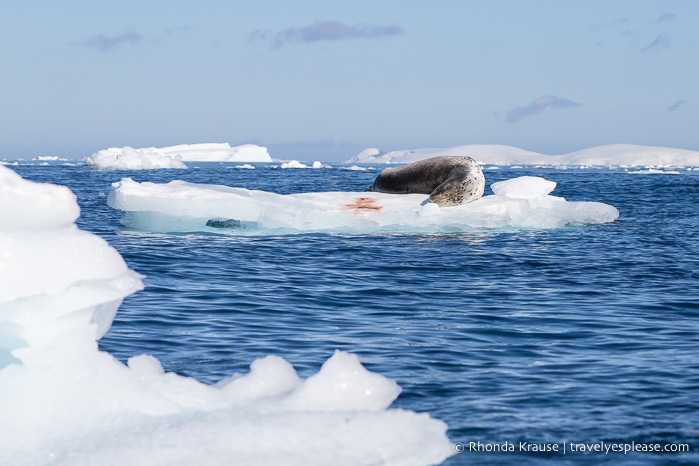
Ross, Weddell, and crabeater seals breed on the sea ice, but fur and elephant seals prefer beaches north of the pack ice zone. Leopard seals mate underwater but birth their pups on ice.
Of the six Antarctic seal species, the only one we didn’t see on our trip was a Ross seal.
Leopard Seal
The most exciting seal encounters of our trip were when we came face to face with Antarctica’s fiercest predator, the leopard seal.
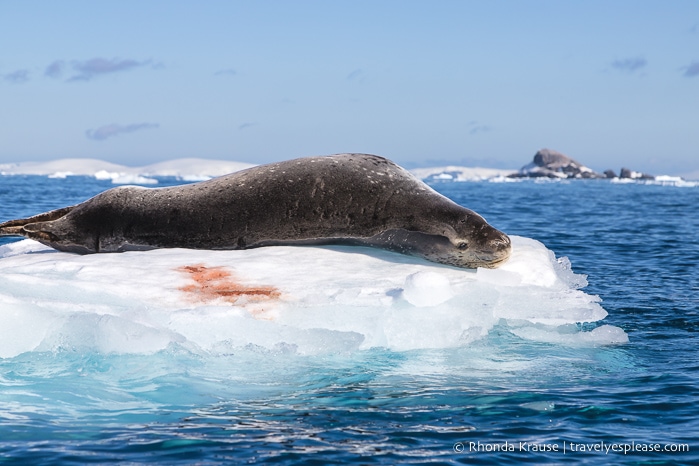
Leopard seals are feared by other Antarctic wildlife because of their predatory skills, stealthily waiting under ice shelves to grab penguins as they enter the water or snatch sea birds resting on the surface. Leopard seals will even feed on other seals.
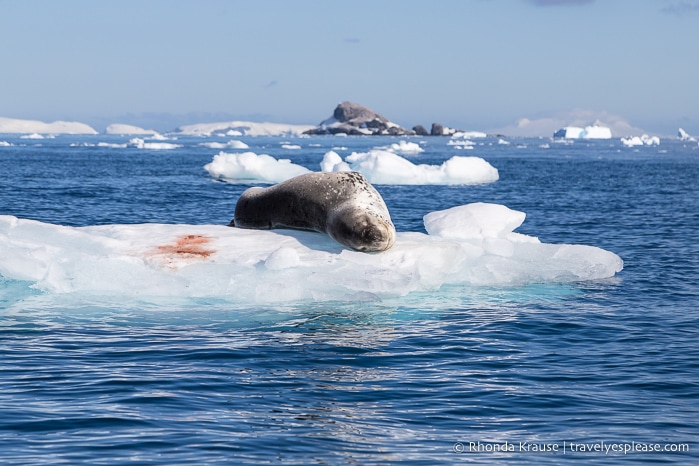
Unlike some of the other seals, there’s no confusing a leopard seal. Their black-spotted grey coats, long sleek bodies, and elongated heads give them a distinct look. With pronounced nostrils and eyes set back on the side of their head, leopard seals almost look reptilian. These merciless hunters even appear to have a sly smile, their wide mouths slightly upturning in the corners.
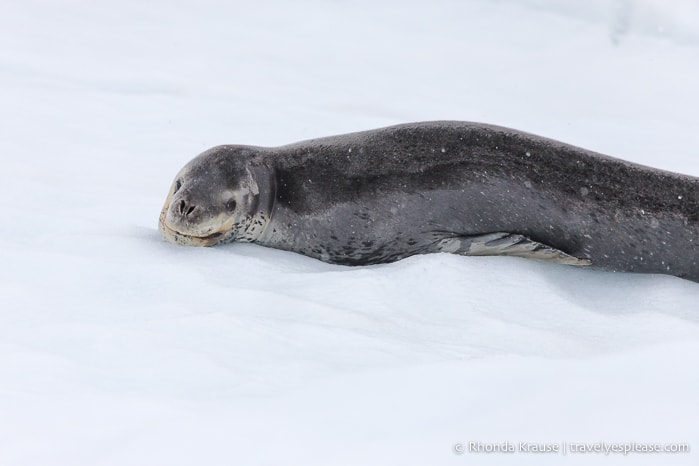
Leopard seals tend to be solitary and the times we saw them they were floating alone on ice pieces. However, some of our fellow passengers on a zodiac cruise witnessed a leopard seal grab and kill a penguin, sending blood flying everywhere as the seal bit in and shook the penguin in its mouth.
Crabeater Seal
Crabeater seals live in Antarctica’s pack ice zone and are the most abundant seal in the Southern Ocean (and world), with an estimated population around 15 million.
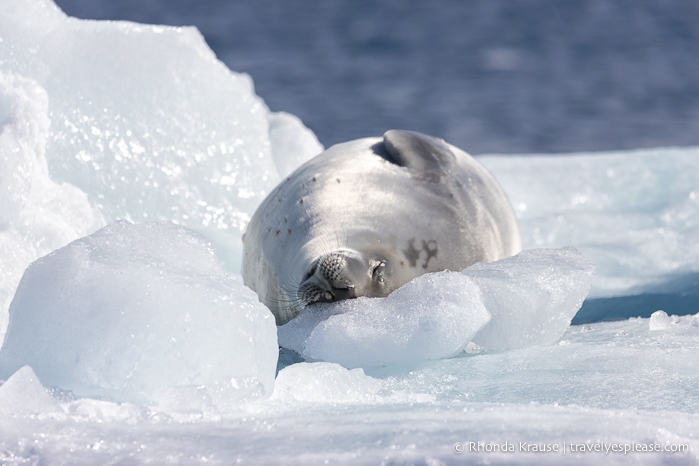
Unlike their name suggests, crabeater seals don’t actually eat crabs. They feed on krill, so it’s believed their name evolved from the German word “krebs”, which refers to crustaceans. Special sieve-like teeth make it easy for crabeater seals to filter krill from seawater.
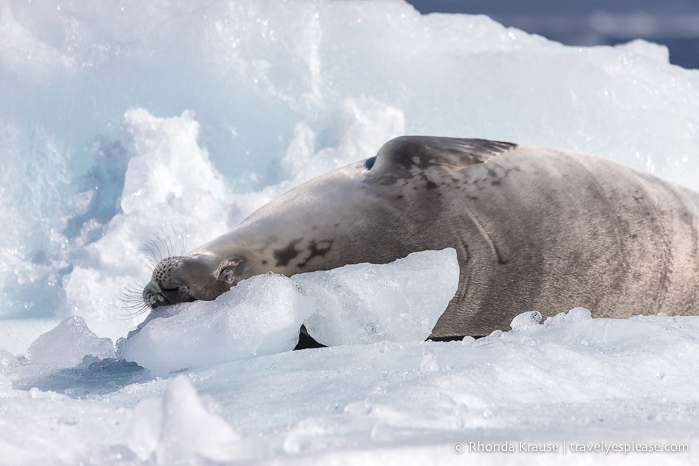
Crabeater seals have a moderately long and slender snout (that looks a bit turned up at the end) and a slight forehead. Their fur can range in colour from tawny brown to light grey, fading to almost white in the summer. A crabeater’s fur is especially pretty in the sunshine when it glistens like sparkling silver.
Crabeater seals can have irregular patches of spots on their sides, especially between their fore and hind flippers. They are also likely to have long scars on their bodies from leopard seal attacks when they were young (likely under the age of one).
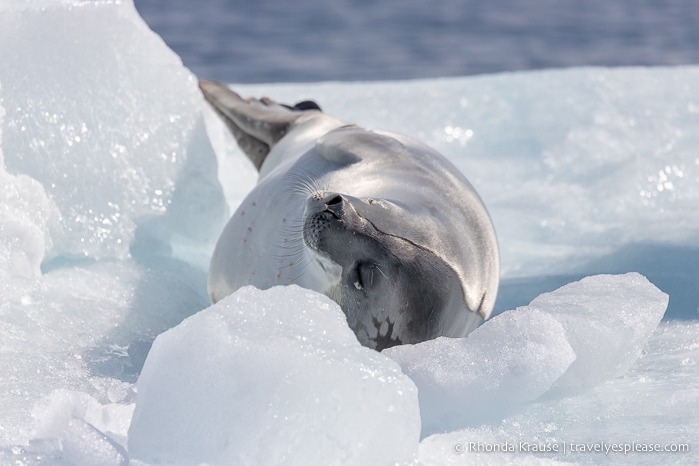
When we saw crabeater seals they were either alone on a piece of sea ice or in a small group resting ashore on the snow.
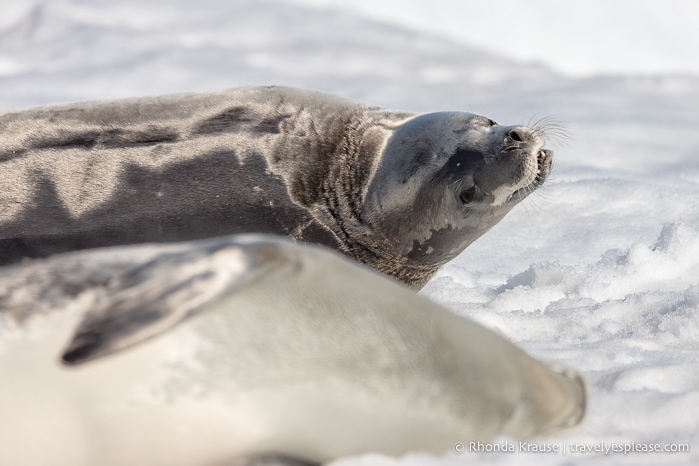
Weddell Seal
Weddell seals have the southernmost range of any seal and prefer to live in fast-ice habitats (ice that’s attached to a shore).
Weddell seals, like crabeater and leopard seals, are true seals without external ears. They are sometimes confused with crabeater seals but can be distinguished by their small round heads, short muzzle, and large forward facing eyes. Weddell seals also have distinctive spots and blotches on their long, thick bodies. Their fur is generally a mix of dark and light grey and off-white.
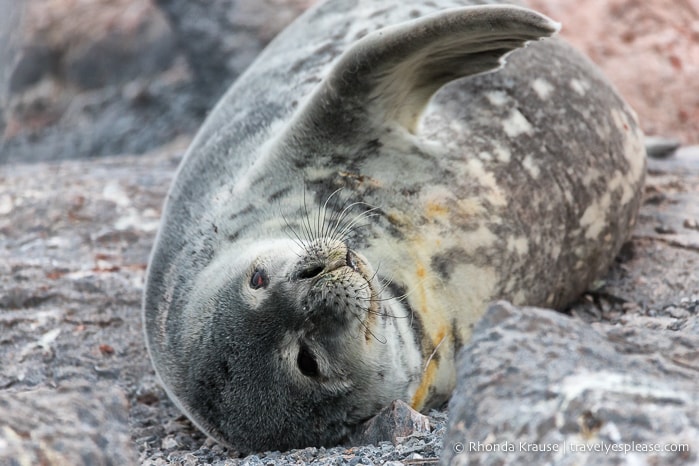
The times we spotted Weddell seals they were alone swimming near the shore or lying contently in the snow.
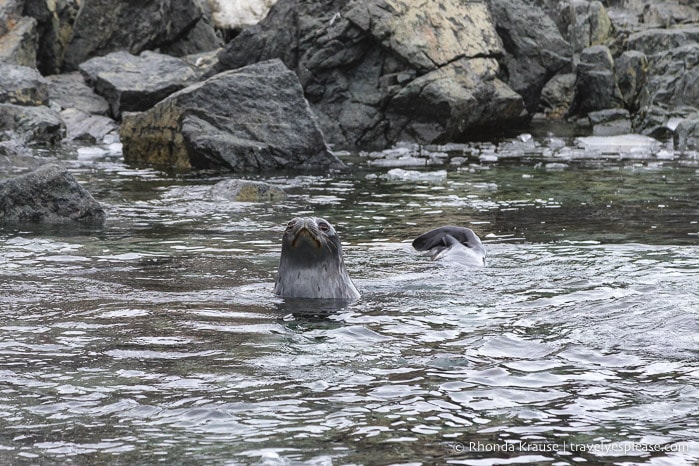
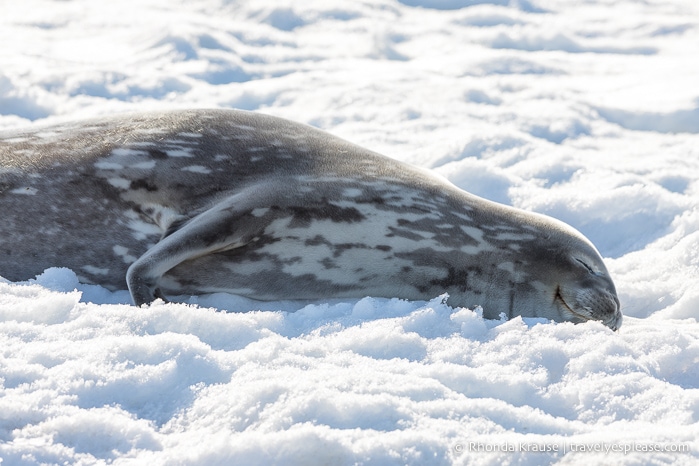
Antarctic Fur Seal
Antarctic fur seals are mainly found on subantarctic islands south of the Antarctic convergence and north of Antarctica’s pack ice zone. They can be seen congregating in large numbers on beaches, especially in South Georgia where about 95% of the world’s Antarctic fur seal population lives. They are believed to be the most abundant fur seal species.
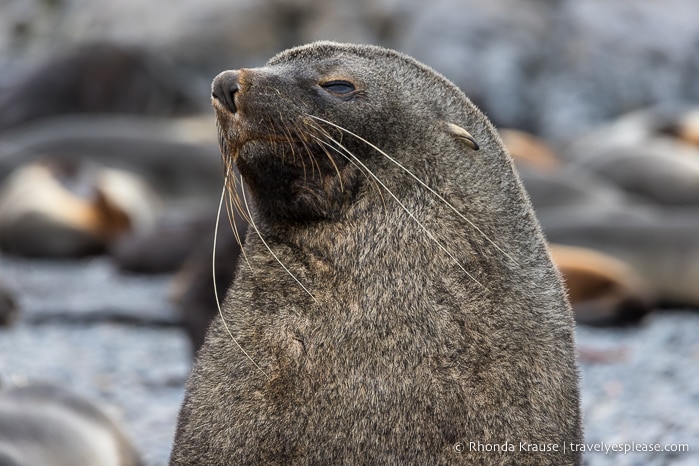
Unlike other seals, Antarctic fur seals have a thick coat of fur for warmth instead of layers of blubber. They are also more active and agile on land since they have the ability to support themselves on their fore flippers and turn their rear flippers forward, allowing them to walk on all fours.
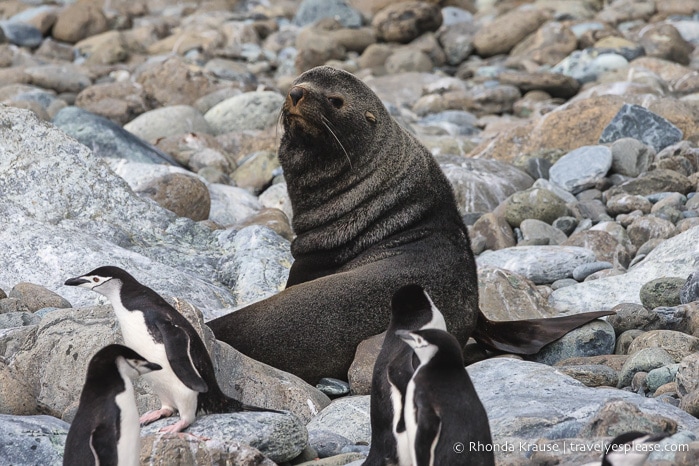
Other characteristics of Antarctic fur seals are external ear flaps, long whiskers, and a pointed muzzle. They are usually brown in colour but occasionally can be pale blonde.
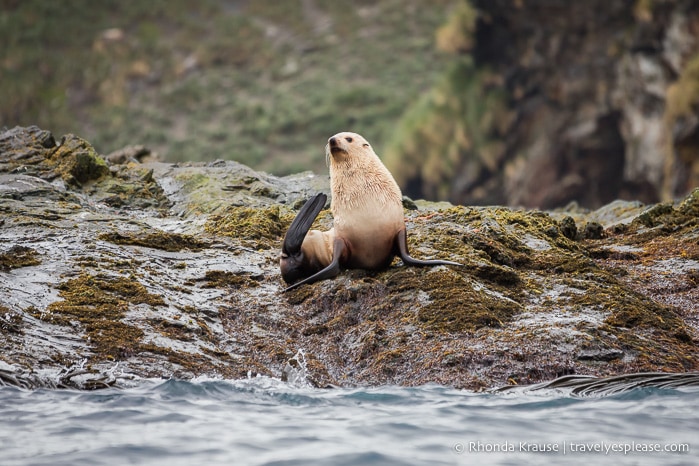
Antarctic fur seals were more fun to watch than other types of seals because they were quite social and energetic, especially the curious pups. They would chase each other around and splash in the water, whereas most other seals we saw were just lazily lying around.
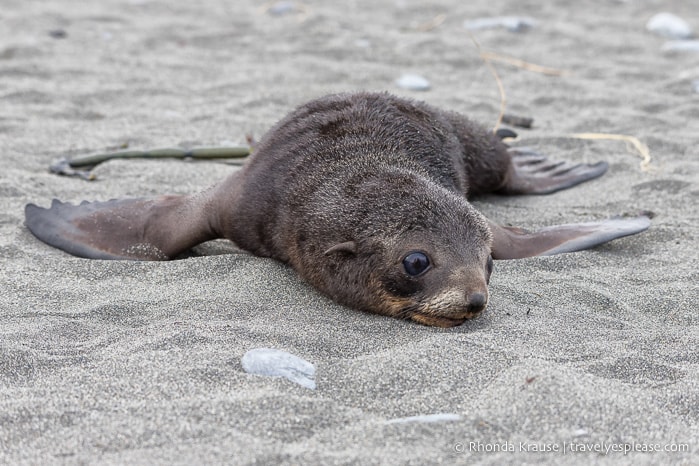
Southern Elephant Seal
Southern elephant seals migrate long distances in the Southern Ocean searching for food, often spending months at sea. They occasionally come ashore in Antarctica, but primarily can be found in subantarctic locations where they gather to breed and moult.
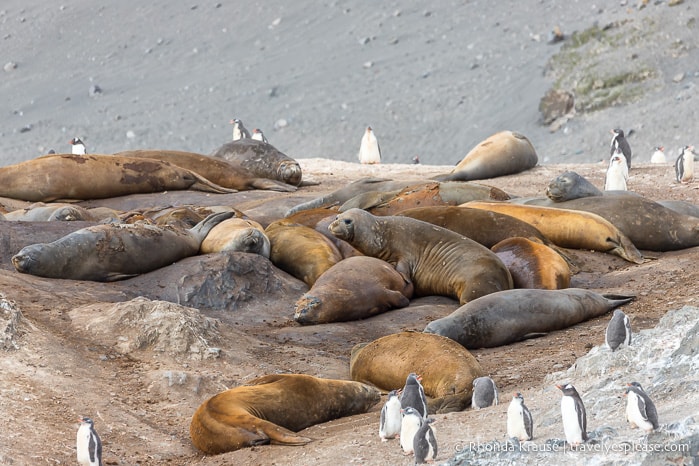
As the name suggests, male elephant seals have a long proboscis (nose) that looks somewhat trunk-like. This inflatable nose is used to generate load roars when asserting dominance. Another thing male elephant seals have in common with their namesake is their huge size, some growing to be over 20 feet long and 8,800 pounds. This makes them the largest of all seals.
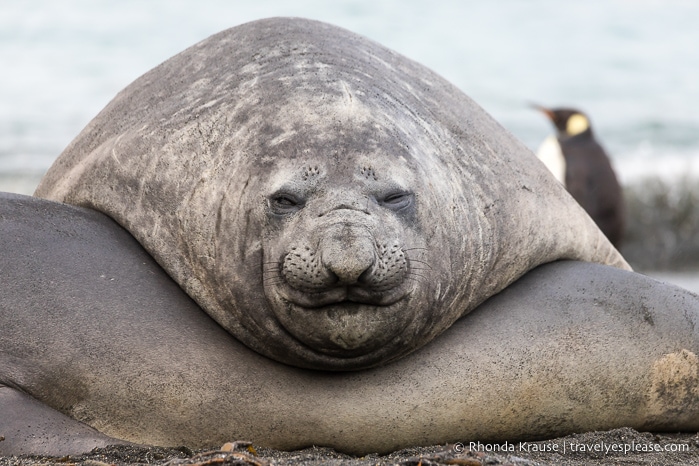
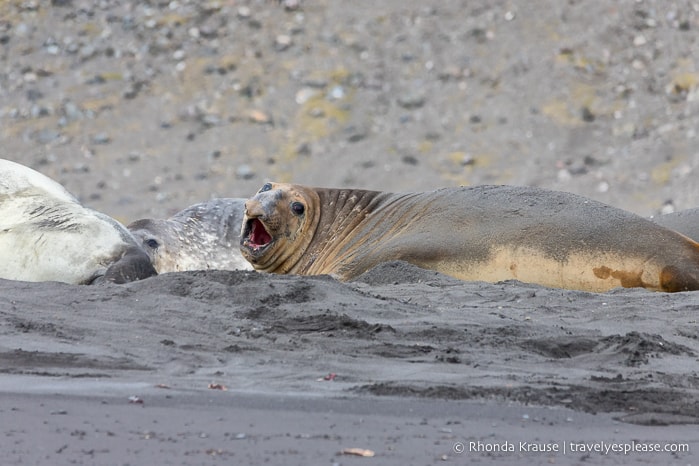
Elephant seals were definitely the least attractive of all the Antarctic wildlife we saw, both in physical appearance and behaviour. They would let out rumbling, steaming belches, have drool hanging from their mouths, and aggressively fight for dominance over their harems of females.
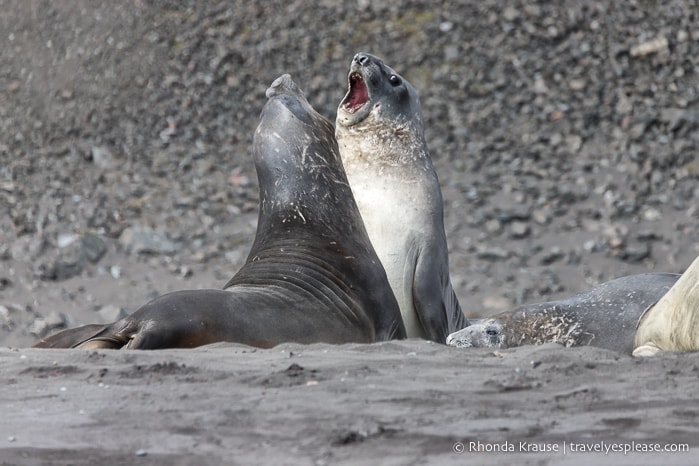
Whales in Antarctica
No other Antarctic wildlife sighting brought as much excitement as seeing whales in the Southern Ocean. Whether it was a pod of orcas hunting off in the distance as night settled in, or a close up encounter with a breaching humpback, these magnificent and intelligent animals made everyone gasp with wonder.
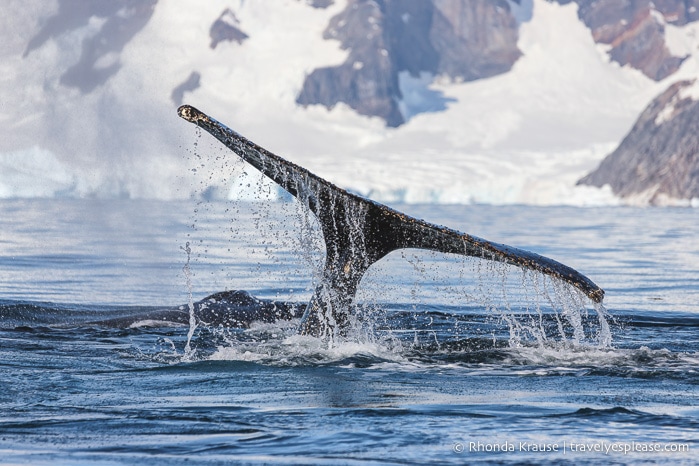
There’s no telling where or when you might spot a whale, but cruise operators make an effort to visit locations where there have been numerous sightings in the past. In general, February and early March are when you’re most likely to see whales in Antarctica, as this is when they have returned from spending winter in more hospitable waters.
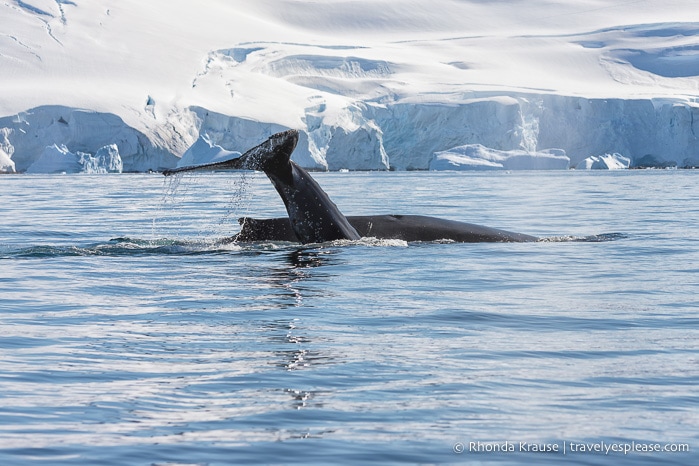
The species of whales most commonly found in Antarctica are humpbacks, orcas/killer whales, fin whales, blue whales, minkes, sei whales, southern right whales, and sperm whales. The whales we saw the most on our trip were humpbacks and orcas, but we also spotted fin whales, minkes, and sei whales.
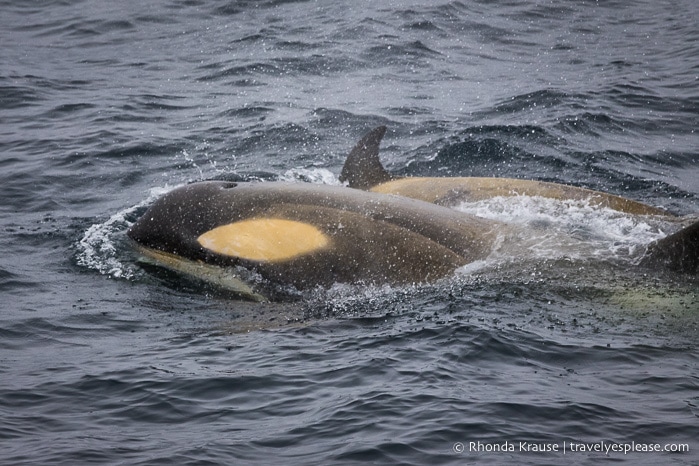
Humpback Whales
Humpbacks are a species of baleen whale, a type of whale that has fibrous plates for straining plankton and small fish from the sea water.
The humpback’s long, bumpy pectoral fins, white throat pleats, and wart-like protuberances on their heads gives them a unique appearance that’s easy to identify. When they dive, their back looks like a large hump, hence the name humpback whale.
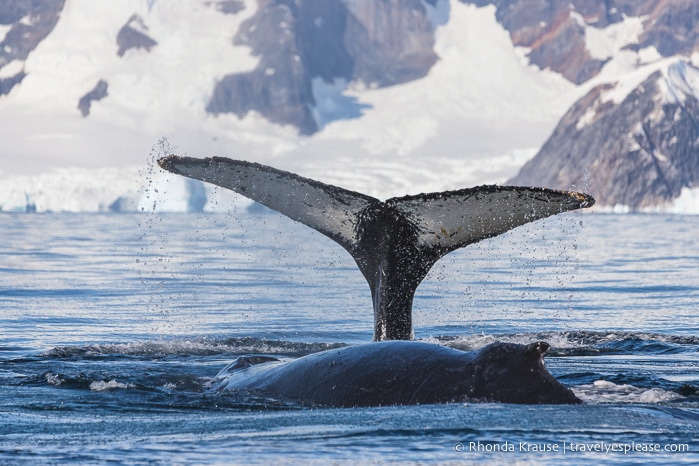
Humpbacks in Antarctica can grow to be 18 m (60 ft) long and weigh between 35-50 tonnes. Their pectoral fins are the largest appendage in the world, topping out at 5 m (16 ft) long.
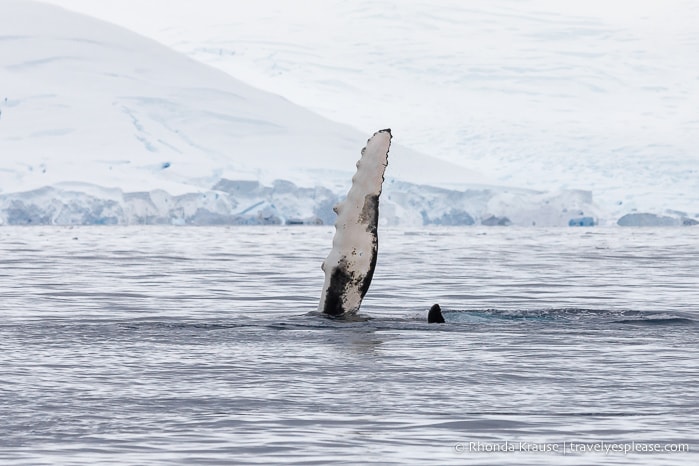
Humpbacks are also quite acrobatic, putting on a show by jumping out of the water (breaching), and slapping their fins and flukes on the water. We were extremely lucky to have found active humpbacks on two of our zodiac excursions. Nothing compares to the thrilling surprise of having a humpback breach right beside your zodiac!
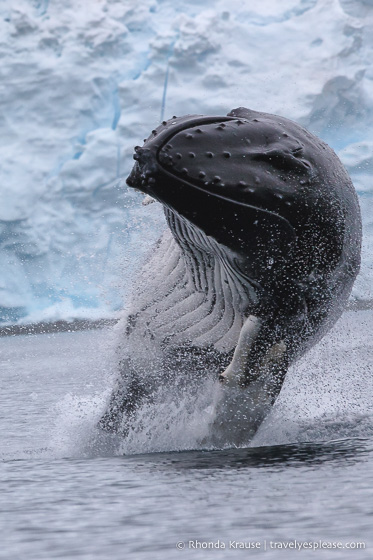
Orcas/Killer Whales
Orcas are a type of toothed whale belonging to the dolphin family. Ranging in size from 7-10 m (23-32 ft) and weighing up to 6 tonnes makes them the largest of the dolphins.
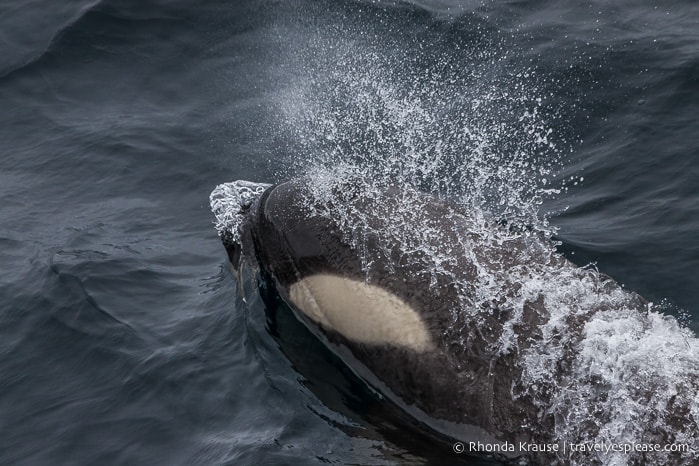
Orcas are also easy to identify because of their tall, triangular dorsal fin and black and white colouring. They have a white patch behind the eye, a white patch on their sides that extends up from their white belly, and a grey “saddle patch” on their back.
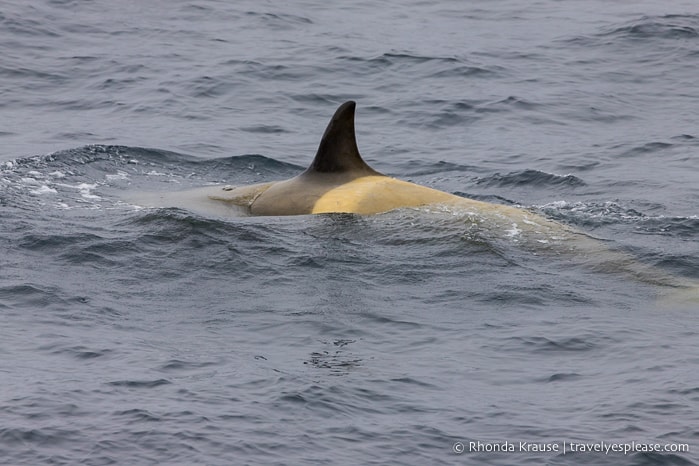
Killer whales are very social creatures and fierce hunters who work together using coordinated strategies to bring down prey. On several occasions we saw large pods of orcas surfacing near our ship and feeding in the distance.
Seabirds in Antarctica (Other Than Penguins)
The Southern Ocean is home to a vast number of seabirds other than penguins thanks to its nutrient rich waters. Only a few species of Antarctic seabirds have the adaptations to breed on the Antarctic continent, nesting in ice-free locations, and the rest have their nesting sites on subantarctic islands.
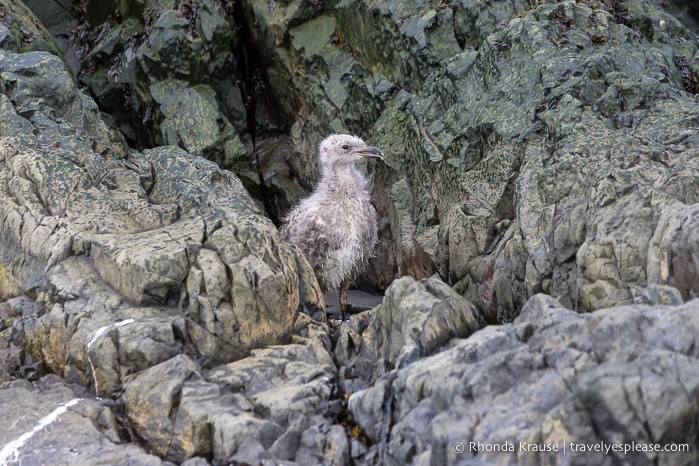
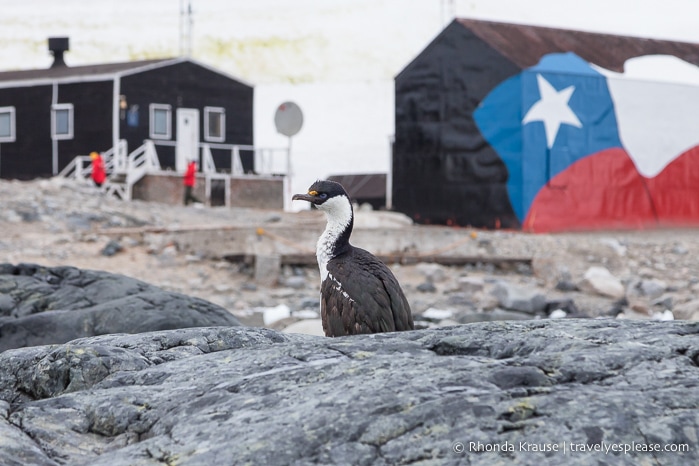
Some of the most common seabirds you can see in Antarctica are varieties of albatrosses, petrels, skuas, shags, gulls, terns, prions, and southern fulmars.

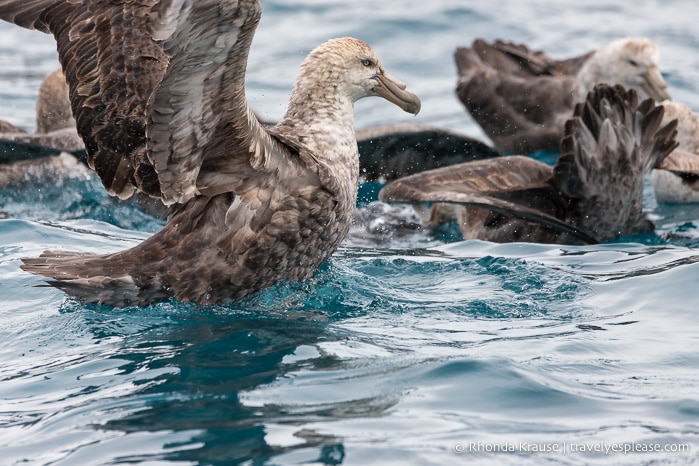
Albatrosses were always fun to see soaring behind our ship with their long wings outstretched. Sightings of wandering albatrosses were especially exciting because they have the largest wingspan of any living bird, reaching over 3 m (10 ft).
Petrels were also a common sight while at sea and on land. We were even lucky enough to spot some nesting giant petrels.
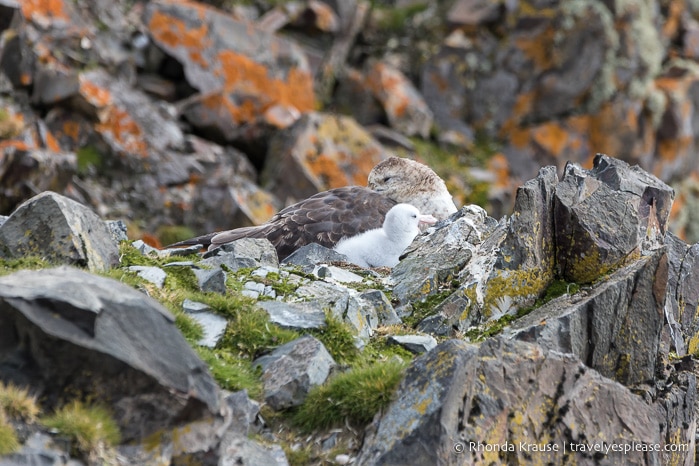
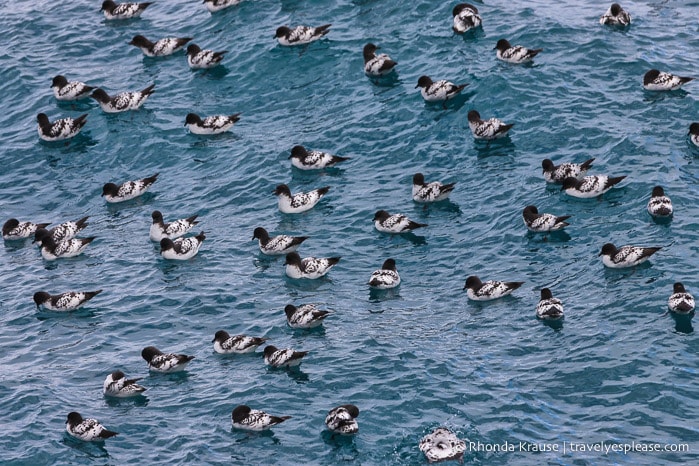
Skuas are prominent in Antarctica and we’d see them attempting to steal eggs from penguins, even going after their very young chicks. It caused quite the commotion in the penguin colony when these avian pirates came around!
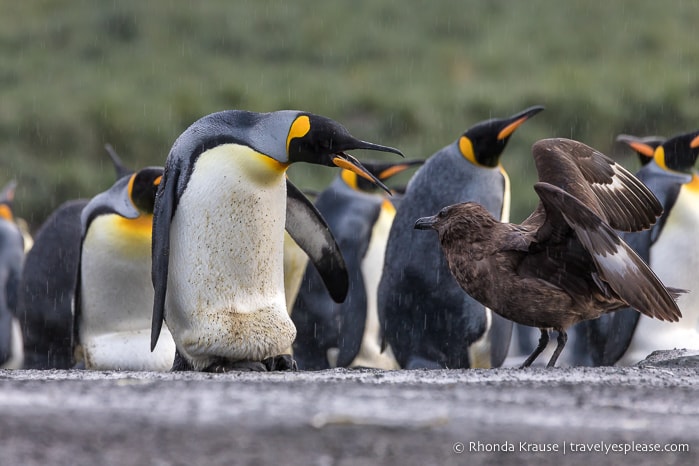
More Interesting Antarctica Wildlife Facts
Did you know that…
- Albatrosses can travel 1,000 km (621 miles) in a single day while at sea.
- The ancestors of today’s penguins stopped flying about 60 million years ago and evolved to be the most efficient swimmers and divers of all birds. They are capable of diving to depths over 250 m (820 ft), but don’t usually go deeper than 10 m (33 ft).
- Southern elephant seals are the deepest diving seals reaching depths of 1,500 m (5,090 ft). The deepest recorded dive for a southern elephant seal was 2,388 m (7,835 ft) and the longest dive lasted 2 hours.
- Leopard seals only natural predators are killer whales.
- Male emperor penguins are responsible for incubating the egg, balancing it on their feet while hidden under a roll of belly fat. The egg can be kept 70°C (126°F) warmer than the outside temperature.
- Macaroni penguins lay two eggs but the smaller egg only produces a chick if the larger egg is lost.
- Orcas have teeth that can be 10 cm (4 in) long.
- Male humpback whales sing songs, possibly to attract a mate, and their songs can be heard 30 km (19 mi) away.
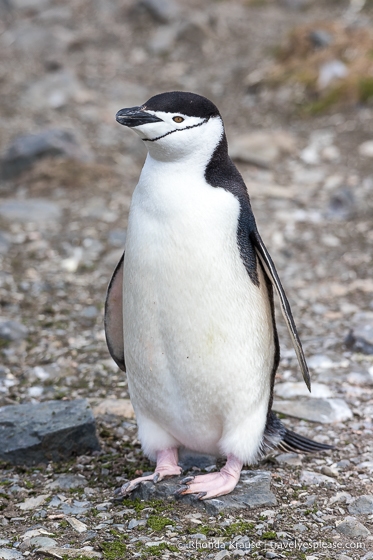
Tips for Viewing Wildlife in Antarctica
Guidelines: To protect Antarctica’s wildlife, there are some common sense guidelines that visitors must follow such as not feeding, touching, or blocking an animal’s path (animals in Antarctica always have the right of way). Walk slowly when near wildlife, keep noise to a minimum, and stay on the perimeter of a colony.
- There are also certain distances you need to keep between you and an animal. Stay 5 m/15 ft from penguins, 15 m/45 ft from fur seals, and 25 m/75 ft from jousting elephant seals. This is tricky with penguins because they are quite curious and will sometimes approach you, but as long as they’re the ones taking the initiative and don’t seem stressed by your presence, then it’s generally okay.
Best Time to See Wildlife in Antarctica: The types of wildlife you see and the behaviour they exhibit depend on what time of year you visit. The Antarctica cruise season is during the austral spring and summer (late October/November to March), which is also the best time to see wildlife in Antarctica. In general, here’s what wildlife activity you can expect to see by month (can vary between species and locations):
- Late October: Penguins and seals are courting and mating, seabirds are breeding, crabeater seals are born (Sept-Nov).
- November: Penguins are building nests and laying eggs, albatrosses can be spotted in the skies, fur seals are born (Nov-Dec).
- December: Seal pups are more commonly seen, whales start to arrive, penguins are laying eggs and their chicks begin to hatch late in the month.
- January: Penguin chicks are newly hatched or about to hatch, whale sightings start to increase, seal pups can be seen.
- February: Best time for whale watching (Feb-early March), penguin chicks and elephant seals are moulting.
- March: Adolescent penguins grow their adult feathers, adult penguins return to the sea to feed, good opportunities for whale watching.
Other Tips: Much of the wildlife in Antarctica can be viewed from a fairly close distance, but binoculars do come in handy at times, especially when scouting for whales on the horizon.
- Quietly sitting still increases your chance of a penguin coming up to you.
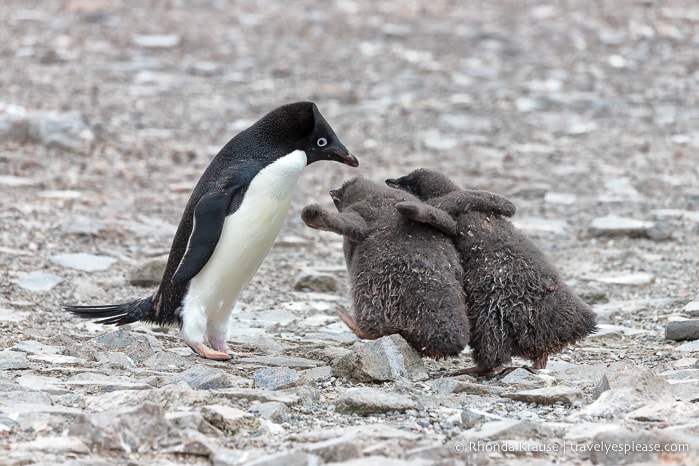
More Antarctic and Subantarctic Travel Guides
- How to Plan a Trip to Antarctica- Things to Consider When Choosing an Antarctica Cruise
- Salisbury Plain, South Georgia- Visiting One of the Island’s Largest King Penguin Colonies
- Grytviken, South Georgia- Visiting an Abandoned Whaling Station
- Things to Do in Stanley- How to Spend 1 Day in the Capital of the Falkland Islands
